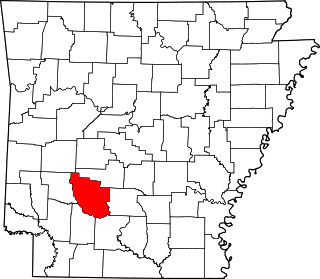
The Champ Grubbs House is a historic antebellum dog trot log cabin in rural Drew County, Arkansas. It is located on Ozment Bluff Road, west of Arkansas Highway 172 and southwest of the county seat of Monticello. The single story log structure is estimated to have been built in 1859, and is one of the few such surviving buildings in the county. It was originally built to a typical dogtrot plan, although separate shed roof rooms were added to its rear in the 19th century, though these were removed and replaced with a similar addition in the 1980s. The center of the dog trot has been enclosed, and is accessed via a door from the front. The eastern log bay also functions as an entry, while that on the west side has been converted to a window. In much of the interior the log finish has been covered by paneling.

The Taylor Log House and Site is a historic plantation site on Arkanasas Highway 138 in rural Drew County, Arkansas, near the town of Winchester. Included on the plantation site is the best-preserved dog trot house in Arkansas's Lower Delta region. The Taylor Log House, a two-story dog trot built out of cypress logs, was built in 1846 by John Martin Taylor, a Kentucky native who established a plantation on the banks of Bayou Bartholomew. The building was moved, probably in the 1880s. In addition to the house, the site is believed to include archeologically significant remnants of a wide variety of outbuildings. The site was the subject of archeological activities in the 1990s.
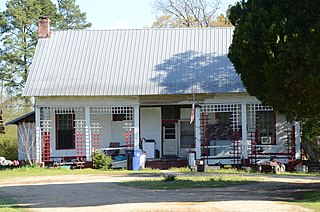
The Smith-McCurry House is a historic house on Arkansas Highway 15, 3.5 miles (5.6 km) east of El Dorado, Arkansas. The oldest portion of the house is a single-story dog trot house that was built in 1867 by Lawson Smith for his son David Carroll Smith. The house was inherited in 1919 by Mamie Smith McCurry, notable as a prominent investor in early oil exploration in Union County. The third well in the county, a successful gusher, was drilled on her land. She the invested further in oil exploration, forming a partnership with Bruce Hunt, a geologist, and the drillers Hensy and Zoda, and eventually participating in exploratory drilling operations in seven states. She used proceeds from her oil successes to expand the homestead and add then-popular Craftsman details to it.

The Hickman House is a historic house at 3568 Mt. Holly Road, in rural Ouachita County, Arkansas, south of Camden. The single story frame house was built in 1898, probably by George Edward Hickman, whose father John was one of the county's early settlers. The house is in Folk Victorian style; it has an L-shaped plan, sheathed in original weatherboard. Its principal ornamentation is in the chamfered posts of its porch, which also has sawn fretwork. The house faces east, and is set about 150 feet (46 m) back from the road; its front facade has two windows above the porch, and two that open onto it. There is a "dog-trot" style barn about 150 feet (46 m) southwest of the house.

The Fielder House is a historic house in Fordyce, Arkansas. Its oldest portion built in 1875, it is the oldest building in Dallas County, predating Fordyce's founding. It stands on the south side of US 79B in the west side of the city, and looks today like a single-story central-hall gable-roof structure with a rear shed addition, and a shed-roof porch extending across the front. The core of the house is a log structure, which is now the west side of the building. In the 1880s the eastern pen was added, creating a dog trot structure, which was then filled in and enclosed by later additions. The house is also notable for being the home of the aunt of author Harold Bell Wright, who is said to have written some of his works there.

The Ed Knight House is a historic house near Pine Grove, a rural community in Dallas County, Arkansas. It is located on County Road 275 off Arkansas Highway 128. In appearance it resembles a double pen house, a narrow and wide structure with a gable roof. Its oldest portion is a dog trot log structure built c. 1880, after which the central passageway was enclosed and an ell added to the south end. This was then sheathed in horizontal weatherboarding. The front facade has a hip-roof porch extending across its width, supported by six turned posts, with jigsaw-cut brackets. The Knights were a prominent local family who settled the area in the 1840s.

The George W. Mallett House is a historic house in Princeton, Arkansas, the first county seat of Dallas County. Built c. 1853 by George W. Mallett, one of the county's first settlers, it is one of three surviving pre-Civil War houses in the county, and the only one in Princeton. The house was originally built as a dog trot; the breezeway was enclosed around the turn of the 20th century, giving the house its present exterior appearance of a central hall structure. A hip roof covers the original portion of the house, while a gable covers a two-room ell added to the rear. A shed-roof porch extends across the width of the main facade, supported by chamfered posts.
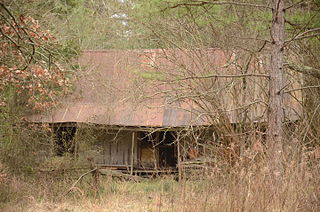
The Dr. Boaz House is a historic house in rural western Clark County, Arkansas. It is located on the south side of Arkansas Highway 26, just west of its junction with County Road 291, near the hamlet of Clear Spring. The dog trot house was probably built c. 1891 by Samuel Peeples as a wedding present for his daughter Annie and Doctor A. Boaz. The house is entirely vernacular in style, and is sheathed primarily in board-and-batten siding. The northern (front) facade has a porch extending its full width, with a chimney on the exterior of the western wall. A kitchen ell extends to the rear (southward) of the western portion of the main block. The house is the finest known instance of the vernacular dog trot form in Clark County.

The Will Reed Farm House is a historic farmhouse on Main Street in Alleene, Arkansas.
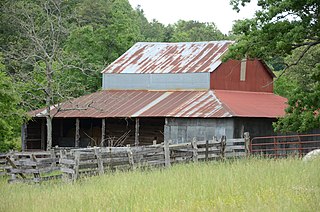
The Rector Log Barn is a historic barn in rural Izard County, Arkansas. It is located on the Rector Plantation, at the end of County Road 218, northwest of Melbourne. Its central portion, a log structure 2-1/2 stories in height, was built c. 1855, and is the only known example in the region of an antebellum era log barn. The main structure is flanked on all sides by 20th-century single-story shed-roof extensions, which serve in part to protect the historic log elements. The barn was built by Joseph William Rector, an early settler of Izard County, probably with the use of slave labor.
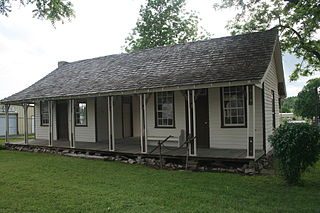
The Casey House is a historic house on the Baxter County Fairgrounds in Mountain Home, Arkansas. Still at its original location when built c. 1858, is a well-preserved local example of a dog trot house, a typical Arkansas pioneer house. It is a rectangular structure made out of two log pens with a breezeway in between. It is finished in clapboard siding on the outside walls, and the breezeway is finished with flushboarding. A porch extends the width of the house front, and is sheltered by the side-gable roof that also covers the house. Colonel Casey, its builder, was one of Mountain Home's first settlers, and its first representative in the Arkansas legislature.
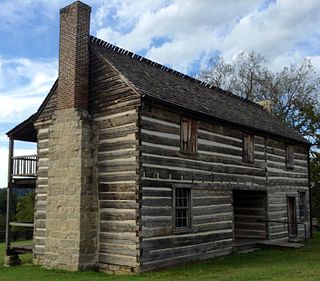
The Jacob Wolf House is a historic house on Arkansas Highway 5 in Norfork, Arkansas. It is a log structure, built in 1825 by Jacob Wolf, the first documented white settler of the area. Architecturally it's a "saddle bag", which is a two-story dog trot with the second floor built over the open breezeway. A two-story porch extends on one facade, with an outside stair giving access to the upper floor rooms. The building's original chinking has been replaced by modern mortaring. It is maintained by the Department of Arkansas Heritage as a historic house museum.
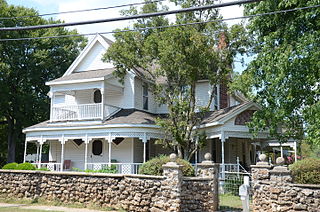
The Carter–Jones House is a historic house located at 30 Carter Street in Yellville, Arkansas.
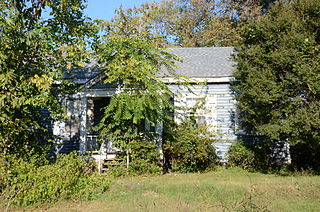
The Wilhauf House is a historic house at 109 North 3rd Street in Van Buren, Arkansas. Built in 1838 and restyled in 1847, it is one of the oldest surviving buildings in the state. It is a single story log dog trot structure, consisting of two log pens originally joined by a breezeway. The house is sheathed in weatherboard, and has a modest Greek Revival gabled portico. The 1847 alterations included the extension of the gable roof to accommodate additional rooms in the rear, which have been furthered extended by a modern addition. The house was built by Leonard Wilhauf on land he purchased from John Drennan, Van Buren's first proprietor.
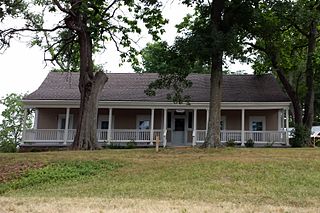
The Maguire-Williams House is a historic house at 19105 Arkansas Highway 74 east of Elkins, Arkansas. It is a 1-1/2 story log and frame structure, finished in wooden clapboards, with a side gable roof. The house appears to have been built between about 1838 and 1877, and includes a frame addition to the rear and an open porch extending across the width of its front. The oldest log pen of the structure has been dated by dendrochronology to c. 1838, with a second wood frame pen, in dog trot layout, added c. 1867. It is one of the county's older antebellum buildings.
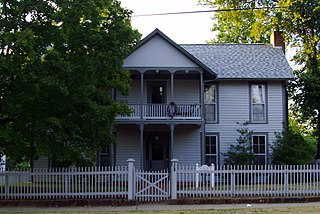
The Ridge House is a historic house at 230 West Center street in Fayetteville, Arkansas. It is owned by the Washington County Historical Society, and is open for tours by appointment.

The Clark-King House is a historic house in Stone County, Arkansas, just outside the city limits of Mountain View. Located near the end of County Road 146, it is a single-story log structure with two pens, one built c. 1885 and the other c. 1889. The main (east-facing) facade has a porch extending across the front, under the gable roof that shelters the original pen. The breezeway between the pens has been enclosed with board and batten siding. The first pen was built by P.C. Clark; the second by Rev. Jacob King, a prominent local circuit preacher of the period.

The Davis Barn is a historic barn in rural Stone County, Arkansas. It is located on the west side of Bob Davis Mountain Road southwest of Pleasant Grove and Mill Creek. It is a single-story wood-frame structure, built on a double crib plan. It has vertical board siding, and an unusually wide driveway between the cribs. Built in 1915, it is a rare 20th-century example of the double crib form, which was more commonly executed in log construction in the 19th century.

The Koon House No. 2 is a historic house at 2959 Arkansas Highway 167 in Sheridan, Arkansas. It is a single story structure, built out of vertically-placed small logs, split in half and set smooth side in and round side out. It is roughly T-shaped, with a frame addition and a carport added later in the 20th century. The house was built in 1936 by Hillary Henry "Pappy" Koon, and is one of several houses built in this distinctive manner in the area by Koon. It is the first of the type he built, and was used as his family residence.

The Henry Crawford Tucker Log House and Farmstead is a 45 acres (18 ha) property near Moultrie, Georgia which was listed on the National Register of Historic Places in 1982. It is located at the end of a long dirt road, about midway between Funston and Moultrie, in Colquitt County, Georgia.






